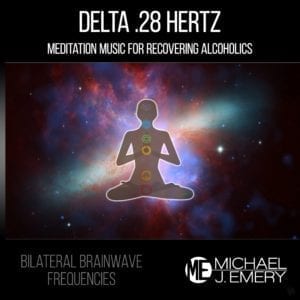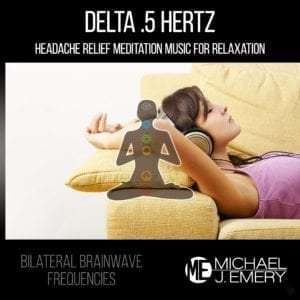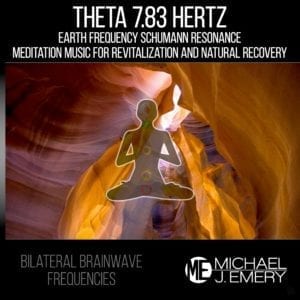Theta brainwave frequencies are commonly referred to as the day dreamer’s brainwave. This is because the wave occurs when a person is still awake but disengaged from outside distractions in the world for inward reflection or in someone who is learning how to meditate. These waves occur from 3-8 Hz. The lower end of the spectrum occurs during sleep while the upper limit of the scale happens during relaxation.
Curiously, theta frequency resonates with the Earth Schumann Resonance that occurs at 7.83 Hz which qualifies it as a theta wave. Theta is one of the most extraordinary and elusive brain states known to man. No wonder it is known as a twilight state since you only experience it briefly when drifting to sleep or when waking up. It is the state where magic occurs in the crucible of your neurological activity.
| Frequency range | Name | Associated with: |
|---|---|---|
| > 40 Hz | Gamma waves | Higher mental activity, including perception, problem solving, fear, and consciousness |
| 13–39 Hz | Beta waves | Active, busy or anxious thinking and active concentration, arousal, cognition, and or paranoia |
| 7–13 Hz | Alpha waves | Relaxation (while awake), pre-sleep and pre-wake drowsiness, REM sleep, Dreams |
| 8–12 Hz | Mu waves | Mu rhythm, Sensorimotor rhythm |
| 4–7 Hz | Theta waves | Deep meditation/relaxation, NREM sleep |
| < 4 Hz | Delta waves | Deep dreamless sleep, loss of body awareness |
Showing all 13 results













Theta brain waves, also known as theta rhythm consist of a neural oscillatory pattern in electroencephalography commonly referred to as EEG signals. These are recorded either from electrodes taped to the scalp or from inside the brain. Basically, there are 2 types of theta brainwaves: the hippocampal and cortical theta rhythms. The hippocampal theta rhythm is a strong pattern often observed in mammals such as dogs, rabbits, bats, and marsupials. On the other hand, cortical theta rhythms are low-frequency oscillations normally recorded from humans.
The theta wave is commonly referred to as the day dreamer’s brainwave. This is because the wave occurs when a person is still awake but disengaged from outside distractions in the world for inward reflection or in someone who is learning how to meditate. These waves occur from 3-8 Hz. The lower end of the spectrum occurs during sleep while the upper limit of the scale happens during relaxation. Curiously, theta frequency resonates with the Earth Schumann Resonance that occurs at 7.83 Hz which qualifies it as a theta wave. Theta is one of the most extraordinary and elusive brain states known to man. No wonder it is known as a twilight state since you only experience it briefly when drifting to sleep or when waking up. It is the state where magic occurs in the crucible of your neurological activity.
For the most part, being able to get into the dreamlike state without falling asleep takes meditation practice. Luckily enough, theta brainwave music can speed up the process which makes it easier to get into the deep meditative state even though you have never engaged in meditation before. This dreamlike state straddles the line between the conscious mind and subconscious. That is why most of them occur between the sleep and awakening period. They also occur in bursts during the dreaming or REM phase. While awake, these waves are only produced during deep relaxation.
Studies show that increased theta activity helps in improving memory recall. To help you understand this, think back to a time when you were in the middle of a mundane activity and suddenly, you remembered something important. Chances are high theta waves played a key role to help you recall that information. Apart from improving memory, these waves are known to help improve your learning ability.
When going through a repetitive activity such as walking home on a highly familiar route, your brain is likely to dip into theta wave activity. This explains why you tend to recall where you placed your car keys while scrubbing the bathtub or slip into a daydreaming state and barely remember driving home.
Theta brainwaves are the best waves to target for brainwave entrainment. They can be harnessed to help people who intend to engage in meditation, improve creativity and enhance learning. For people suffering from chronic anxiety and stress, theta waves entrainment might offer the solution they need to unwind as well as calm down. These waves can also be used by insomniacs to induce sleep and lucid dreaming to help in restoring and promoting total mind and body well-being.
Since theta helps you to access the regions of the mind that are almost impossible to access during the conscious state, it is considered an ideal state for people who want to engage in ways to learn for good or starting out using a free self hypnosis download. It is also recommended for people who want to re-imprint program their subconsciousness and store information in long-term memory. In addition, since theta state is associated with heightened receptivity and reprogramming of the mind, it is an ideal state for people who want to change their habits and behaviors.
In theta, you are in a waking dream. During this period, receptivity is heightened which means you are able to gain access knowledge and information that is normally beyond your conscious awareness. The awareness you access during the theta state is critical for finding answers you need but cannot get from a self help coach or other people. These are answers that reside deep in your subconscious mind and can only be found during this state.
While theta brainwaves are ideal for faster learning and accessing knowledge beyond the normal human reach and many other benefits, they also have their downsides. Theta waves are known to contribute to feelings of depression until the person moves to the alpha or beta range. In addition, these waves can make it extremely difficult for people suffering from attention deficit disorder (ADD) to concentrate and focus.
If you have any concerns, you are encouraged to speak with a licensed medical practitioner who can advise you regarding your health and the use of brainwave frequencies.
Explore audio program categories utilizing the best techniques in neuro-linguistic programming, Ericksonian hypnosis, brainwave frequencies, and guided visualization.